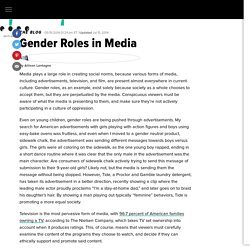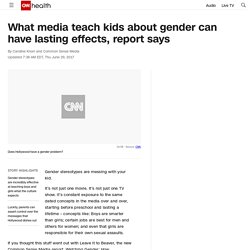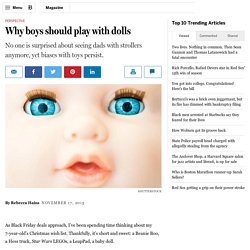

Difference between sex and gender. Understanding gender roles and stereotype. How do children learn about gender stereotypes? Children and Media. Types of media influences on gender roles. Gender Roles in Media. Media plays a large role in creating social norms, because various forms of media, including advertisements, television, and film, are present almost everywhere in current culture.

Gender roles, as an example, exist solely because society as a whole chooses to accept them, but they are perpetuated by the media. Conspicuous viewers must be aware of what the media is presenting to them, and make sure they’re not actively participating in a culture of oppression. Even on young children, gender roles are being pushed through advertisements. My search for American advertisements with girls playing with action figures and boys using easy-bake ovens was fruitless, and even when I moved to a gender neutral product, sidewalk chalk, the advertisement was sending different messages towards boys versus girls.
The girls were all coloring on the sidewalk, as the one young boy rapped, ending in a short dance routine where it was clear that the only male in the advertisement was the main character. Impacts on media influence on the children. Girl toys vs boy toys: The experiment - BBC Stories. Gender stereotypes and education. How Toys Impact Children's Development. Children Learn Quickly: a Short Lesson in Neuroplasticity Children are extremely fast learners.

For newborns, the world is a flood of information and they absorb it like a sponge. Connections between neurons in the brain called 'synapses' form, and because children have the ability to take in large amounts of information, the number of connections in a young child's brain (particularly babies and toddlers) are far greater than an adult's. This is because, unlike adult brains which ignore irrelevant information, the developing brain takes in everything, and forms neural connections that are virtually useless. As the child develops, certain synapses which are used more and more are strengthened and become more efficient. Children go through sensitive learning periods, or 'critical periods', in which they are particularly sensitive to certain information.
While some skills and systems require development in their respective critical learning period(s), others can be learned later in life. What media teach kids about gender can have lasting effects, report says. It's not just one movie.

It's not just one TV show. It's constant exposure to the same dated concepts in the media over and over, starting before preschool and lasting a lifetime -- concepts like: Boys are smarter than girls; certain jobs are best for men and others for women; and even that girls are responsible for their own sexual assaults. According to the report, which analyzed more than 150 articles, interviews, books, and other social-scientific research, gender stereotypes in movies and on TV shows are more than persistent; they're incredibly effective at teaching kids what the culture expects of boys and girls.
What makes these messages stick -- and harder for parents to counteract -- is that they're timed for the precise moment in kids' development when they're most receptive to their influence. Think of preschoolers who are just beginning to identify as boys or girls. These oversimplified characterizations play out in many ways over and over. Age 2-6 At this age, kids: Age 7-10. Gender stereotypes in mass media. Case study: Analysis of the gender stereotyping phenomenon in TV commercials. Mass media play a significant role in a modern world, by broadcasting information in fast pace and giving entertainment to vast audiences.

They consist of press, television, radio, books and the Internet. The latter is now the most developing medium, however, TV also has a wide field of influence. By creating a certain type of message, media can manipulate people’s attitude and opinions. I would like to focus on this problem by investigating commercials structure; I will also attempt to specify gender stereotypes, which are used in advertising as a persuasion technique. Stereotypes People organize their knowledge about the world around them by sorting and simplifying received information. One of the most important types of schemes used for orientation in the social environment are the stereotypes, representing the opinions among members of a certain group about the other groups. Why boys should play with dolls - The Boston Globe.
As Black Friday deals approach, I’ve been spending time thinking about my 7-year-old’s Christmas wish list.

Thankfully, it’s short and sweet: a Beanie Boo, a Hess truck, Star Wars LEGOs, a LeapPad, a baby doll. The fact that this is a boy’s list might spark some surprise, since it includes a classic “girl” toy, a baby doll to nurture. But today we’re on the cusp of a new children’s culture in which delineations between so-called girls’ and boys’ toys — between dolls and diesel trucks — won’t exist. My son spends equal time playing with boys and girls and delights in playing house and video games alike. “Toys are for everybody,” he insists with admirable stubbornness.
But not everyone sees it that way. Get Today's Headlines in your inbox: The day's top stories delivered every morning. How can parents assist in their child's understanding of gender roles? Conclusion.